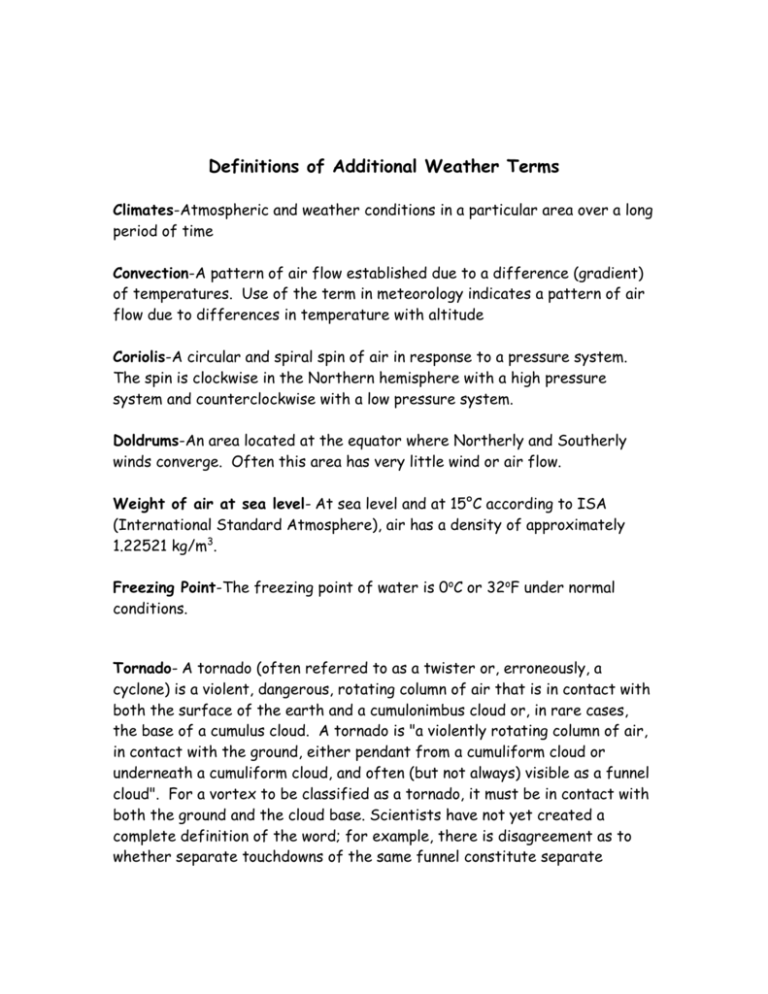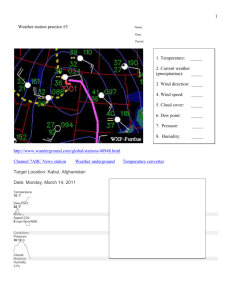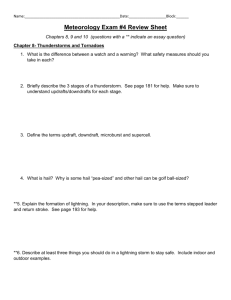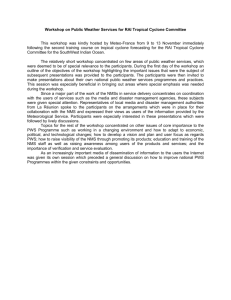Definitions of Additional Weather Terms
advertisement

Definitions of Additional Weather Terms Climates-Atmospheric and weather conditions in a particular area over a long period of time Convection-A pattern of air flow established due to a difference (gradient) of temperatures. Use of the term in meteorology indicates a pattern of air flow due to differences in temperature with altitude Coriolis-A circular and spiral spin of air in response to a pressure system. The spin is clockwise in the Northern hemisphere with a high pressure system and counterclockwise with a low pressure system. Doldrums-An area located at the equator where Northerly and Southerly winds converge. Often this area has very little wind or air flow. Weight of air at sea level- At sea level and at 15°C according to ISA (International Standard Atmosphere), air has a density of approximately 1.22521 kg/m3. Freezing Point-The freezing point of water is 0oC or 32oF under normal conditions. Tornado- A tornado (often referred to as a twister or, erroneously, a cyclone) is a violent, dangerous, rotating column of air that is in contact with both the surface of the earth and a cumulonimbus cloud or, in rare cases, the base of a cumulus cloud. A tornado is "a violently rotating column of air, in contact with the ground, either pendant from a cumuliform cloud or underneath a cumuliform cloud, and often (but not always) visible as a funnel cloud". For a vortex to be classified as a tornado, it must be in contact with both the ground and the cloud base. Scientists have not yet created a complete definition of the word; for example, there is disagreement as to whether separate touchdowns of the same funnel constitute separate tornadoes. Tornado refers to the vortex of wind, not the condensation cloud. Hurricane- A tropical cyclone is a storm system characterized by a large low-pressure center and numerous thunderstorms that produce strong winds and heavy rain. Tropical cyclones strengthen when water evaporated from the ocean is released as the saturated air rises, resulting in condensation of water vapor contained in the moist air. They are fueled by a different heat mechanism than other cyclonic windstorms such as nor'easters, European windstorms, and polar lows. The characteristic that separates tropical cyclones from other cyclonic systems is that at any height in the atmosphere, the center of a tropical cyclone will be warmer than its surrounds; a phenomenon called "warm core" storm systems. The term "tropical" refers to both the geographic origin of these systems, which form almost exclusively in tropical regions of the globe, and their formation in maritime tropical air masses. The term "cyclone" refers to such storms' cyclonic nature, with counterclockwise rotation in the Northern Hemisphere and clockwise rotation in the Southern Hemisphere. The opposite direction of spin is a result of the Coriolis force. Depending on its location and strength, a tropical cyclone is referred to by names such as hurricane, typhoon, tropical storm, cyclonic storm, tropical depression, and simply cyclone. Tsunami- A tsunami, also called a tsunami wave train, and at one time incorrectly referred to as a tidal wave, is a series of water waves caused by the displacement of a large volume of a body of water, usually an ocean, though it can occur in large lakes. Tsunamis are a frequent occurrence in Japan; approximately 195 events have been recorded. Owing to the immense volumes of water and the high energy involved, tsunamis can devastate coastal regions. Earthquakes, volcanic), landslides and other mass movements, meteorite ocean impacts or similar impact events, and other disturbances above or below water all have the potential to generate a tsunami eruptions and other underwater explosions (including detonations of underwater nuclear devices. Isobar-A line on a weather map indicating the same barometric pressure along the line. Isotherm-A line on a weather map indicating the same temperature along the line. Dew Point- The dew point is the temperature to which a given parcel of humid air must be cooled, at constant barometric pressure, for water vapor to condense into water. The condensed water is called dew. The dew point is a saturation temperature. The dew point is associated with relative humidity. A high relative humidity indicates that the dew point is closer to the current air temperature. Relative humidity of 100% indicates the dew point is equal to the current temperature and the air is maximally saturated with water. When the dew point remains constant and temperature increases, relative humidity will decrease. CFC’s-An acronym for chlorofluorocarbons which are/were used for propellants, refrigerants, and foaming agents. Some CFC’s are atmospheric pollutants causing depletion of ozone in the stratosphere. Leaded Gasoline-Gasoline previously contained (completely banned in 1995) a lead compound (tetraethyl lead) that was used as an anti-knocking agent in automobiles and other internal combustion engines. The lead released by automotive exhaust or from other internal combustion engines was a major environmental pollutant and accumulated in biological food chains.








